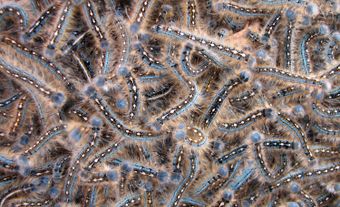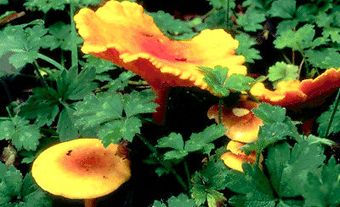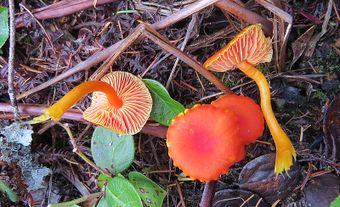All members of the kingdom Fungi are commonly known by the same name, fungus. Fungi have some characteristics in common with both plants and animals, yet they are an independent group. Plants, animals and fungi are thought to have a common ancestor, probably a simple eukaryotic (cells having distinct nuclei) organism highly unlike its modern descendants. Evidence suggests that fungi and animals are more closely related to each other than either is to plants. Like animals, all fungi lack chlorophyll and cannot carry out photosynthesis.

Structure
Fungi may occur as independent single cells or as multicellular organisms. The fundamental structure of multicellular fungi is the hypha (tubular tissue), usually subdivided by septa (cross-walls). Hyphae not partitioned by septa are termed coenocytic. Although coenocytic hyphae may constitute a single elongated cell, they contain many nuclei and function more like multicellular structures.
Did You Know?
Multicellular fungi can come in all kinds of shapes and sizes, from the better-known cap and shelf fungi to the lesser-known jelly fungi. Some fungi, such as the Devil’s Finger fungus, have unique shapes.

Classification
Although mycologists have named only about 60,000 species of fungi, the actual number is closer to 1.5 million. Some mycologists still consider this estimate to be low. If this figure is accepted, then 94% of all existing fungi have yet to be named. Large-scale destruction of natural habitats by human development and climate change may preclude the discovery of most of these.
Recent advances in molecular biology have stimulated a renewed interest in fungal classification. Currently, the kingdom Fungi contains five major phyla (i.e., groups): Chytridiomycota (chytrids), Zygomycota (conjugated fungi), Ascomycota (sac fungi), Basidiomycota (club fungi) and Glomeromycota.
Chytridiomycota are largely unicellular aquatic or semiaquatic and usually have swimming stages in their life cycles. They are the only fungi to have flagella. Zygomycota are small, nonmotile, primarily terrestrial, and have relatively simple life cycles that lack extended diploid or dikaryotic stages. Ascomycota contains the majority of known fungi, including many yeasts used in baking, brewing and wine fermentation, as well as many edible mushrooms. Basidiomycota includes many of the species found in natural landscapes, like gilled fungi, shelf fungi, and several rusts. Many of these are very important plant pathogens. Glomeromycota is a newer classification which primarily includes fungi that form arbuscular mycorrhizae, meaning that they form mutually beneficial relationships with plants.

Habitat
Fungi grow in almost all environments from the tropics to the high arctic: in soil, freshwater, seawater and in association with many other organisms. Nearly every plant and animal, including humans, has at least one fungal parasite. Species attacking human skin or lungs are relatively few but are difficult to treat. Fungi are highly specialized in their nutrient requirements as well as in their patterns of mating and dispersal. Each species is unique for one or more of these features, making it perfectly suited for living in narrowly defined environments. The great biodiversity of non-fungi organisms (living and dead), differences in moisture levels, temperature and other factors worldwide account for the impressive diversity of fungi.
Reproduction and Dispersal
Fungi are known for their varied modes of reproduction. Fungi are able to reproduce both sexually and asexually, though certain species can only do one or the other. Both sexual and asexual reproduction in fungi involves the creation of spores, which disperse from the parent organism to a new location.
Spores can disperse in a variety of ways. It is usually said that most spores are dispersed by air currents, although studies of airborne fungi using spore traps usually report a limited number of species. Insects, mites, and other arthropods are probably more important to fungal dispersal than is generally supposed. Other aids to fungal dispersal include water splash and currents, gut passage through invertebrates and vertebrates and even motility of the spores themselves.
Did You Know?
One species of fungi, Schizophyllum commune, has as many as 23,000 different sexes. Though this species pushes for the extreme, having many different sexes is a relatively commonplace occurrence among fungi.
Diet
Fungi require two main nutritional components in order to survive and thrive: carbon (or energy) and minerals.
Carbon nutrition is not substantially different from that of animals and usually involves the orderly oxidation of hexoses (6-carbon sugars) such as glucose. This most often occurs aerobically by the normal process of respiration but may also be carried out anaerobically (i.e., by fermentation).
Mineral nutrition of fungi can resemble that of plants, whereby all necessary minerals (nitrogen, phosphorus, sulphur, iron, etc.) can be assimilated in simple inorganic forms. On the other hand, most fungi can also assimilate minerals combined in organic molecules.
One of the most characteristic features of fungi is their ability to digest complex sources of nutrition outside their cells and then absorb the resulting product. This process is carried out by extracellular enzymes specialized for digesting one or a few specific substances. Fungi produce extracellular enzymes to digest cellulose, starch, pectin, wood, hair, skin, and numerous other substances. Each fungus produces a characteristic set of these enzymes, but none produces all.
Although many fungi are saprotrophs (grow on dead organic materials), others are parasites and derive their nutrition from other living organisms. In most cases, fungi are specialists and can only grow on and eat very specific substances.
Associations
Fungi commonly have mutualistic and parasitic associations with other living organisms.
Fungal mutualisms are numerous and widespread. The most well-known of these are lichens and mycorrhizae. Lichens are the result of a mutualistic association between fungi and algae The resulting "dual organism" can live in environments too hostile to support the growth of either the alga or the fungus alone. They are also a favourite food source for caribou and often an air quality indicator. Mycorrhizae are mutualistic associations between fungi (assimilates mineral nutrients) and the roots of plants (a sugar source). The two benefit from each other greatly, and a growing body of research suggests that mycorrhizae fungi are crucial for a healthy forest.

Parasitic fungi are equally numerous and important. These attack members of most major groups of organisms. Of greatest importance to humans are those that cause plant disease. Among these diseases are wheat stem rust (Puccinia graminis), which reduced Canadian crops in the first half of the 20th century; other cereal rusts (Puccinia), which take a continuing toll; white pine blister rust (Cronartium ribicola), which nearly eliminated the eastern white pine; cereal smuts (Tilletia, Ustilago); potato late blight (Phytophthora infestans); sunflower downy mildew (Plasmopara halstedii); onion downy mildew (Peronospora destructor); chestnut blight (Cryphonectria parasitica), which virtually destroyed the American chestnut; and apple scab (Venturia inaequalis), which often causes heavy losses. Another important aspect of fungal activity is the production of serious toxins in moldy grain.
Although many fungal diseases cause losses to agriculture and forestry, it must be recognized that most wild plants have fungal parasites and yet can grow and reproduce without substantial interference from them. Recent studies show that healthy tissues of many plants yield numerous fungi, occasionally over 100 from a single plant species. These fungi do no visible harm to the plant and may even be beneficial. In addition, disease is a natural part of a landscape. At moderate levels, it promotes an overall healthy ecosystem.
Devastating losses occur only when large areas are planted to one, often genetically uniform, crop. In natural grasslands, many grass species usually occur in mixed stands. The same is true of natural forests. This variety buffers the association against violent change, and rusts and other fungi, although present, do little harm. Agricultural fields, silvicultures (tree farms), and other areas where one species is overwhelmingly dominant are the greatest risk.
Biological Importance
Although not strictly parasitism, the decay of living trees is important in natural forests. Decay often occurs in the nonliving heartwood portion of forest trees and may weaken them to the point that they fall. Decay occurs chiefly in overmature or wind-thrown trees; fungi speed the recycling of wood and bark into usable nutrients. This process allows the creation of new and healthy soil and fosters heterogeneous landscapes where many different species can thrive.
In managed forests, decay can be very costly, and trees are cut while relatively young to reduce loss from decay. This may have unwanted consequences because slash may stimulate the growth of decay fungi, and the remaining trees may become damaged and provide sites for infection. With fungi that are adapted to all trees and various climates and given that managed forests often contain little species diversity, the problem is complex.
The breakdown of grasslands, litter in forests, and other biomes is as important as tree decay, although it is less spectacular. Each habitat has an elaborate sequence of fungi, bacteria, and minute animals that completely reduce tissues to plant nutrients. Fungi are especially important in severe climates (e.g., arctic deserts) that have minimal bacterial activity. What little soil and organic litter there are in these landscapes, which allow the next generation of plants to grow, is thanks, in part, to fungi.

Relationship with Humans
The fungi best known to city dwellers are conveniently, if inexactly, termed molds. They include the various coloured growths that occur in damp environments on fruit, bread, cheese, leather, and other organic substances, and they involve members of several groups of fungi.
These fungi are more than just pests; many produce dangerous mycotoxins that threaten the health of anyone who eats them. Mycotoxins can diffuse through foods, and it is important to discard the contaminated substance and not just remove the mold. Research on mycotoxins is an important activity in government and university laboratories in Canada and many other countries.
Molds can also contaminate indoor air through their spores or by producing toxic substances. Recent studies have linked indoor mold contamination to serious health problems for the occupants. It is now believed that houses with moldy interiors are as great a threat to the health of children as parental smoking.
Although plant disease and mold contamination are serious problems, fungi are incredibly important organisms that provide many useful and indispensable services to humans in addition to their ecological roles. Most notable among these are the yeasts, single-celled fungi. Yeast fermentation is responsible for breadmaking and the production of alcohol.
Some fungi also produce antibiotics, such as penicillin, one of the great success stories of the 20th century, produced by species belonging to Ascomycotina (Penicillium). A worldwide search is underway for new fungal products that can safely combat diseases, insect pests, weeds, and other threats to our comfort and security.
Did You Know?
Penicillin is believed to have saved many millions of lives since its discovery and was especially crucial to the recovery of injured soldiers during World War II. As antibiotic resistance rises, in part due to the incorrect use or even overuse of antibiotics in certain contexts, it is critical that medical researchers can research more fungi and plants for their potentially life-saving properties. As wild landscapes continue to be in decline due to human activity, it may be especially challenging to find these organisms before they go extinct.
Some mushrooms belonging to Basidiomycotina are widely known for their edibility. Chanterelles and morels are especially prized. The cultivation of edible mushrooms is an important activity in Canada. In Ontario, mushrooms are considered one of the most important vegetable crops.

See also Biology and Crop Research.

 Share on Facebook
Share on Facebook Share on X
Share on X Share by Email
Share by Email Share on Google Classroom
Share on Google Classroom






